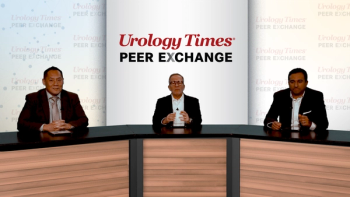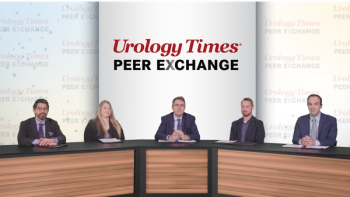
Once patients are ready to explore treatment, Fosnight stresses the importance of shared decision-making.

Once patients are ready to explore treatment, Fosnight stresses the importance of shared decision-making.

The data, presented at ESMO, support a role for gemcitabine intravesical system plus cetrelimab in MIBC.

Nicholas Deebel, MD, shared key takeaways from a recent review outlining the current evidence on post-vasectomy pain syndrome.

Mechanisms of Action and Differentiation Among ARPI Therapies in mCSPC

Current Treatment Landscape and Guideline Recommendations in mCSPC

A key finding was that 86% of patients required no additional therapy after receiving nadofaragene.

Muhammed A. Moukhtar Hammad, MBBCh, highlights ongoing work to develop a machine learning model to predict inflatable penile prothesis complications.

The experts discuss how recent therapeutic advances and trial data are reshaping standard care in advanced prostate cancer.

Alicia Morgans, MD, MPH, and Paul Sieber, MD, introduce the discussion, outlining goals to connect evolving mCRPC research with personalized immunotherapy practice.

Rahul Aggarwal, MD, shares key takeaways from the PRESTO trial as well as remaining questions in the field.

Stacy Loeb, MD, MSc, PhD (Hon), debunks common misconceptions about prostate cancer and offers suggestions as to how urologists can help push back against misinformation.

An expert discusses strategies for optimizing perioperative immunotherapy use, managing toxicity, and ensuring adherence as KEYNOTE-905 transitions from trial evidence to clinical practice.

Matthew A. Love, MD, discusses key efficiency and safety considerations for the SURE procedure.

One particularly striking finding from KEYNOTE-905/EV-303 is the nearly 60% pathologic complete response rate.

This discussion emphasizes practical implementation. Freedland outlines how urologists and medical oncologists can collaborate to ensure timely therapy initiation and shares insights into patient- and disease-specific factors that drive the choice of androgen receptor inhibitor in clinical practice.

The phase 3 AMPLITUDE trial evaluated the safety and efficacy of adding niraparib to abiraterone acetate plus prednisone in patients with mHSPC.

The expert faculty discuss persistent challenges and unmet needs in managing high-risk non–muscle invasive bladder cancer (NMIBC), emphasizing the impact of Bacillus Calmette–Guérin (BCG) shortages on patient care. They note that many cases of BCG-unresponsive disease stem from inadequate transurethral resection or incomplete adherence to BCG induction and maintenance protocols. The conversation highlights that, despite BCG’s proven efficacy, inconsistent delivery and supply constraints limit real-world outcomes. Faculty members describe how institutions are adapting to intermittent shortages by adjusting maintenance schedules, reducing doses, or sharing limited supplies among patients. They also explore the broader implications of supply issues, including barriers to clinical trial enrollment and variability in treatment access across regions. The panel underscores the urgent need to expand BCG production capacity, develop standardized rationing strategies, and investigate alternative or replacement therapies to ensure consistent and effective treatment for patients with high-risk NMIBC.

Panelists discuss how real-world comparisons of apalutamide and enzalutamide suggest survival trends influenced by tolerability, adherence, and patient selection rather than intrinsic drug differences.

The discussion opens with an overview of the evolving management of high-risk non–muscle invasive bladder cancer (NMIBC) and introduces the session’s goals of reviewing the treatment landscape, recent clinical data, and best practices for integrating new therapies. The expert faculty emphasize that accurate risk stratification is foundational to guiding treatment decisions. They review major guidelines, including those from the AUA/SUO, EAU, and NCCN, and explain how patients are categorized into low-, intermediate-, and high-risk groups based on tumor grade, size, and pathologic features. The conversation highlights key differences between these frameworks and how they influence clinical decisions in practice. The faculty note that most patients fall into the intermediate- or high-risk categories, with high-risk disease carrying the greatest threat of recurrence and progression. They also discuss the need for multidisciplinary collaboration and early risk assessment to inform appropriate, bladder-sparing therapeutic strategies in NMIBC management.

Panelists discuss how recognizing and mitigating common biases in real-world prostate cancer data helps clinicians interpret findings responsibly and apply them effectively in patient care.

Data suggested that most patients do not have a preference on the gender of the urologist who is providing their vasectomy care.

Jason M. Hafron, MD, CMO, touches on the growing shift toward biomarker-driven therapy in advanced prostate cancer.

Joshua J. Meeks, MD, PhD, highlights that collaboration between urologists and medical oncologists has become essential.

Jason M. Hafron, MD, recaps noteworthy prostate cancer research from ESMO 2025.

Stacy Loeb, MD, discussed key takeaways from the European Randomized Study of Screening for Prostate Cancer.

Stacy Loeb, MD, shares key takeaways from her LUGPA 2025 session, “Current state of prostate cancer screening.”

Beyond radioligands, Henderson points to a number of novel therapeutic categories under investigation.

Henderson emphasized the evolving role of advanced biomarkers in refining prostate cancer risk assessment beyond traditional PSA testing

Andrew W. Hahn, MD, highlights safety and tolerability data on lenvatinib/everolimus vs cabozantinib for metastatic ccRCC.

An expert discusses how KEYNOTE-905 establishes a new evidence-based systemic therapy option that transforms the management and prognosis of patients with muscle-invasive bladder cancer.